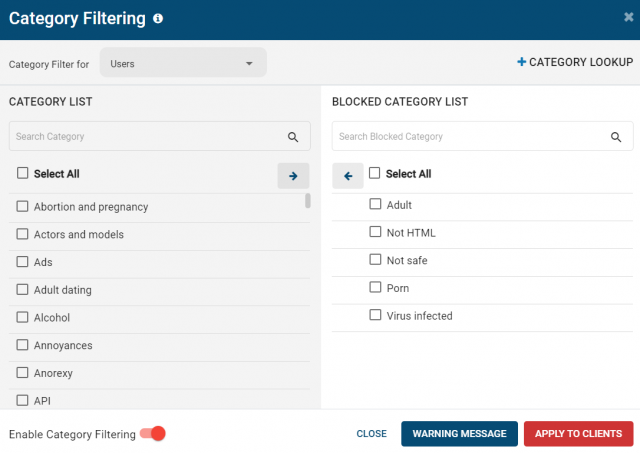

Express VPN which is SSL based OpenVPN, or try ). SSL VPNs will do this automatically without messing up settings (e.g. Try to use HTTPS instead of HTTP which is: instead of, sometimes company forgetting to filter HTTPS sites. Following general methods are worth to try:.Create a new group ACL or edit an existing one, then in the 'time' drop-down box select the schedule you created.ĭon't forget to click apply on the general tab for the settings to take effect. Schedules can be applied using the groups ACL tab. You can create as many different schedules as you need.
Request blocked by url filter database plus#
To create a time-based rule, click on the times tab and then click the plus sign to create a new schedule. If you are filtering your home network, you may not want the kids visiting certain sites during the school week, this is another example where you would use a time-based rule. Schedules are useful for applying rules at different times during the day or only on certain days of the week.įor example, you could apply strict URL filtering rules during business hours and automatically disable the rules after 5 PM. SquidGuard also allows you to apply URL filtering based on schedules. īlock searches for "proxy bypass" on Google and Yahoo For more useful information about filtering on regular expressions, check out. These could be edited depending on what you intend to filter out. Then go back to the common or group ACL tab and select the action (deny, allow, etc.) for your target category.īelow are a few examples of filtering expressions. Enter the expression you want to filter on in the expression box and then click save. To create a filter that uses an expression, click on the target categories tab and either create a new category or edit an existing one. If you are unfamiliar with regular expressions, they can be somewhat confusing at first, but there are many online resources on the subject, so I won't go into too much detail about them in this article. These types of filters are great when you want to search for certain strings of text in a URL to make a filtering decision. In addition to domain and URL filtering, SquidGuard can create filters using regular expressions. For example you could redirect the users to google if you want to.Ĭreating new target categories Filtering by Expression You can change the redirect page to be a blank page, or any other internal or external URL. This will prevent your users from bypassing the filter by simply using the IP of the web site instead of the URL.īy default, when a user attempts to visit a blocked page, they will see an internal error page indicating that the page was blocked and which target category it falls under. I would recommend enabling the setting to block IP addresses in the URL.


For example, if you want to apply heavy filtering on a group of computers in a lab while granting unrestricted access to computers in another network, you would use the group configuration. If you want to apply different rules to other source networks you should use the groups ACL tab. The common access list settings will apply to all users of the proxy. The simplest method of configuration is to use the common ACL tab. After uploading your blacklist, you will need to configure which categories should be allowed, blocked, or whitelisted.


 0 kommentar(er)
0 kommentar(er)
